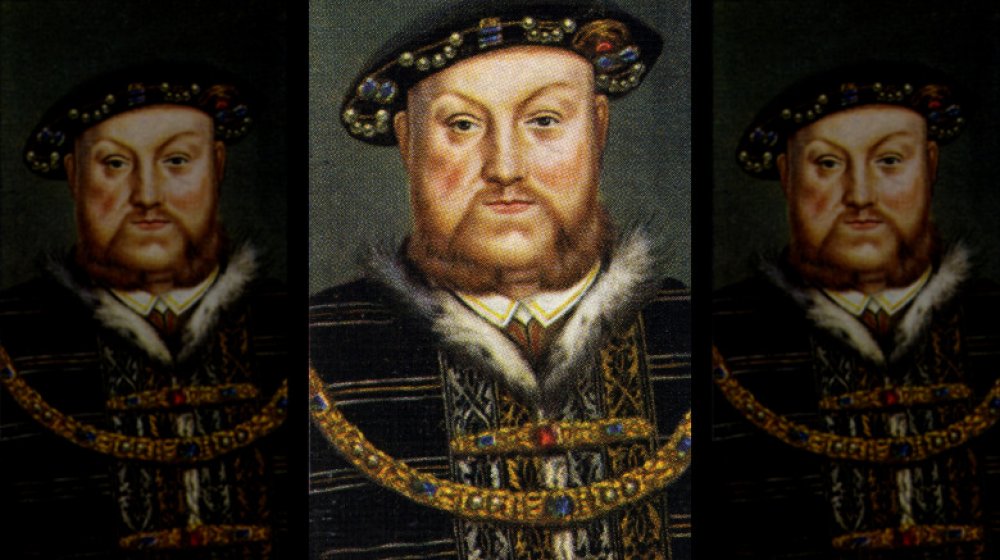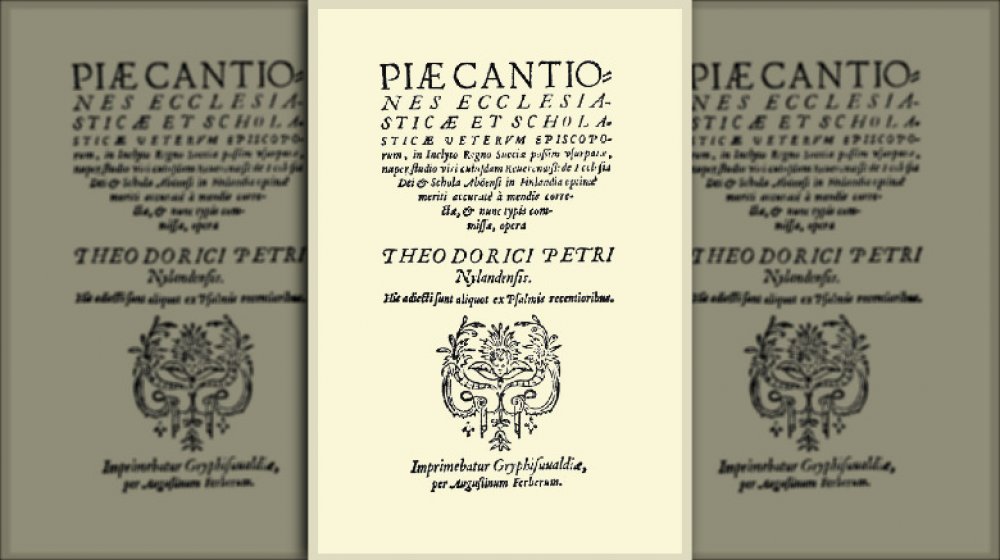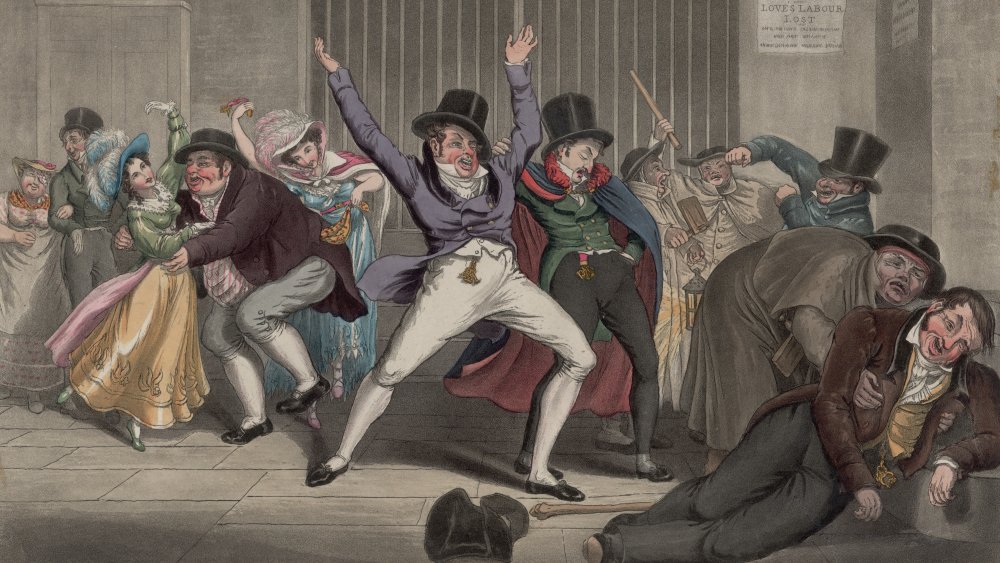The Bizarre History Of Caroling
The end of the year means the holiday season, and that means a whole host of wholesome, comforting traditions. One of the most wholesome and comforting of those traditions is caroling, when a group of people gathers and goes out in public to sing. Now, people sing in public at other times, whether it's the crazy person on the subway who appears to be singing a tuneless song about the spaghetti monster, or an ambitious artist seeking some publicity, but caroling is special. Caroling is all about spreading cheer and joy, celebrating the season, and harkening back to a more innocent time.
It wasn't always like that. Caroling isn't a 19th-century invention, as some think. The origins of caroling — as well as some of the songs we still sing — go back thousands of years. The path that this form of music and social performance has taken from its earliest religious roots to its current secular practice is a long, twisting one. Along the way, caroling has been suppressed by the church, considered dangerous and banned outright, and contributed to a comeback for a little holiday known as Christmas. Once you know the bizarre history of caroling, you'll never view walking around your neighborhood singing something like "Hark, the Herald Angels Sing" the same way again.
The earliest carols were pagan
Although many modern carols are secular in nature (and many religiously-themed carols have been absorbed into the secular zeitgeist), we still think of caroling as a traditionally Christian practice because of its association with Christmas. As Slate notes, this makes carols unique in the world of music and spirituality: No other religion has a catalog of weird old popular songs performed by the general public during specific times of the year.
Slates goes on to explain how the earliest carols (like many aspects of Christianity) were actually adapted from existing pagan songs. Many pagan religions had traditions of group singing during their holidays, so it was pretty natural for folks to just use those old tunes. The Catholic Church didn't much like that, as it is the official position of most religions that other religions are kind of wrong. So the church did the most Boomer thing it could have done and it wrote its own carols in an attempt to control the narrative. There's evidence of one of these new carols as early as the fourth century.
Unfortunately, those replacement carols weren't very popular. For one thing, they were written in Latin, just like everything else in the church back then. For another, they tended to be little lectures on church doctrine in musical form. As a result, these "acceptable" carols weren't very popular.
Caroling originally had nothing to do with Christmas
In modern times, caroling is firmly associated with the Christmas holiday. Cheerful carolers are an iconic part of the Christmas holiday even for non-Christians. Most of the people who head out into the cold to sing traditional tunes don't expect much in return.
But when caroling began, it was quite different. Back in the Middle Ages, there was a tradition called "wassailing." As Arcadia Publishing explains, wassail was derived from an Old Norse phrase ves heill, which loosely translates to "be well." Wassail was also the name of a traditional spiced drink not too different from our modern eggnog. As The Daily Meal notes, back in the days of feudal lords, the peasants who lived under the nobles' protection (but who didn't own the land they worked) lived pretty hard lives. It became a tradition for them to go and sing carols outside the lord's house, and receive hot cups of wassail and food in exchange.
While wassailing was done during the cold months (when the poor folks might need a few free drinks and plates of food to survive the winter), it wasn't associated with Christmas. In accordance with the old definition of wassail, the songs usually focused on wishing their lord good health and good news, which of course lines up well with the spirit of the modern holiday.
Saint Francis of Assisi made carols part of Christmas
If you think going to mass in the modern era is kind of boring, you've never imagined mass in the Middle Ages. The Church did everything in Latin back then (and actually up until 1965), which almost none of the regular folks in attendance could understand. The whole church-going experience was rather dour. As HowStuffWorks notes, the best way to describe the official church Christmas music up until the 13th century was "somber."
Then came Saint Francis of Assisi. As Slate explains, Francis broke with tradition and remade Christmas into a celebration. He began organizing nativity scenes and parades to get people excited about the holiday. His most exciting change was to allow people to sing songs in their native language. Just as the early Christians had taken pagan songs and re-worked them, people in the 13th century took their drinking songs and changed the lyrics to be about Christmas.
The Church wasn't thrilled by this, but as Arcadia Publishing notes, these new Christmas carols were very popular, and people began singing them outside of church. The carols were then passed down orally within families, from generation to generation. This means you can trace the tradition of caroling at Christmas directly from Saint Francis' decision to let people sing fun songs.
Carols once included a dance component
In the modern sense, the term "carol" simply indicates a traditional holiday-themed song that a group of people can sing. But the carol is a specific type of music that has undergone a lengthy evolution. In the earliest days of Christianity, most of the religious songs were borrowed from old pagan ceremonies. When the Church began creating its own music to counter that trend, it began the musical tradition that eventually became a specific type of music known as the carol.
As Liberty Park Music explains, the origins and history of the songs we know as carols are pretty complicated. In the 12th century or so, a form of music originated in France called a carole. This was a simple musical tune accompanied by a choreographed dance, marked by a repeated refrain. As the Middle Ages progressed, the dance portion got left behind (thank goodness), but the term became applied to a specific kind of song composed of a repeated refrain with stanzas in-between. These carols were also what's known as
"monophonic," meaning they had just one melody line. Here's an example of a medieval carol sung by a choir. As you can hear, it isn't exactly the jaunty holiday song we think of today when we think of caroling. Eventually, people began taking popular songs and changing the lyrics to celebrate Christmas, and the modern carol slowly took shape.
Carols became a popular artistic form
Today, carols are quaint old songs you sing because they're traditional, not because they're considered good or popular music. But there was a time in history when carols were considered a worthwhile art form. As explained by The British Library, carols remained popular for centuries for several reasons. On the one hand, they were generally religious in nature and thus were approved of by the Church. On the other, it was part of the carol tradition that they were re-worked and given new lyrics. This kept many ancient carols alive in society during a period of history when carols were rarely written down and were handed down via oral tradition.
Carols were popular enough that some famous and powerful people tried their hand at composing them. As The British Library notes, one carol that was written down was called "Green Groweth the Holly," and it was composed by none other than King Henry VIII of England. Henry was a talented artist, poet, and musician and many of his poems are still studied today. But "Green Groweth the Holly" was not exactly a hit song in his time. You can listen to it here and judge for yourself whether it deserves to join "We Wish You a Merry Christmas" in the caroling canon.
Carols weren't written down until the 16th century
It's hard to believe today, but the Christmas carols that people sang throughout the centuries were usually not written down. When people in the Middle Ages would go from house to house during the cold weather, singing well-wishers in exchange for cups of a hot, spiced drink called wassail, they generally sang songs that had been taught to them by the older generations. And in church, the songs celebrating Christmas and other religious themes were usually in Latin, were quite boring, and had similarly been taught to them orally.
In the 13th century, people began changing the ribald words of popular wassailing songs to be more Christmas appropriate, and carols became very popular. But they still weren't written down, because most people weren't literate. As Arcadia Publishing notes, these carols were handed down orally through the generations until the late 16th century.
As author Ronald M. Clancy notes, in 1582, a man named Theodoricus Petri Rutha collected several old Latin songs into written form for the first time, in a book called the Piae Cantiones. The book contains the earliest written version of the all-time classic carol "Good King Wenceslas" and preserved the carols until their resurgence in popularity in the 19th century.
Caroling became a big problem
Caroling began as a medieval tradition of people singing outside the houses of wealthy nobles, expecting cups of hot, spiced beverages in return. That sounds very quaint and charming, but as time went on, the tradition turned a little dark. There was a long period of time where caroling and even celebrating Christmas was frowned upon.
As Salon reports, the Puritans (the same serious folks who traveled to America on the Mayflower) knew that many of the seasonal celebrations, including Christmas, stemmed from old pagan rituals and even retained some of the ancient pagan aspects. Among these objectionable aspects were cross-dressing, a holdover from saturnalias — and caroling. They opposed these celebrations on the grounds that there was nothing godly or spiritual about getting really drunk and making a loud, profane fool of yourself.
At the same time, caroling had evolved from cheerful peasants singing for mugs of eggnog into rowdy groups of drunks descending on rich folks' houses and demanding food and drink. In fact, some wealthy landowners would pool their money and hire security teams to protect their property from roving bands of carolers. As historian Thomas Christensen notes, one minister in the early 1700s described caroling as occurring "in the midst of Rioting, Chambering [fornication], and Wantonness."
Caroling was banned in England for a time
The 17th century was a weird time in England. The King was overthrown and beheaded in 1649, and a man named Oliver Cromwell ruled the empire as Lord Protector until his death in 1658 (at which point the monarchy was restored). Cromwell was part of the Puritan movement that sought to cleanse the church of its immoral trappings. As the BBC reports, Cromwell and the Puritans didn't just think celebrating Christmas was unnecessary. They thought it was sinful, a relic of the Catholic Church that only brought violence and immoral behavior. And the fact that carols were traditionally religious songs celebrating the birth of Jesus Christ didn't save them. The Puritans regarded all singing, even religious songs, to be immoral.
It might sound like the plot of a children's novel, but as HowStuffWorks notes Christmas was actually legally canceled by Parliament between 1649 and 1660. Caroling continued under Cromwell's regime, but it was forced to go underground and become secretive. The result was as intended: Even after Cromwell's death, Christmas celebrations were no longer as popular and common as they had been, and caroling fell out of fashion. As Slate says, for the next two centuries, caroling faded from popular memory and was rarely engaged in, at least publicly.
Carols helped bring Christmas back
After the Puritan crackdown on Christmas in England in the late 17th century, Christmas celebrations fell out of fashion for about 200 years. As the BBC reports, in the early 19th century, most businesses in England didn't even bother closing for the holiday. And as The Guardian notes, the increasing urbanization and industrialization of the world meant people were working longer hours under terrible conditions. At the same time, they were displaced from their traditional rural homes and the oral traditions that had thrived there. The end result was a country where Christmas was barely thought about.
A few things sparked a Christmas revival in the 1800s. As Slate notes, Queen Victoria married the German Prince Albert, and he imported many German Christmas traditions, including the Christmas tree, which became popular. And many prominent people worked consciously to bring the holiday back, like Charles Dickens. Dickens' A Christmas Carol was written in part to revive the celebration of Christmas. In fact, the Ghost of Christmas Past was used to describe the sort of raucous Christmas celebration that hadn't happened in a very long time.
Carols played a huge part in bringing Christmas back. In 1822, a man named Davies Gilbert published a book of carols, which became instantly popular. In 1833, another collection by William Sandys appeared, including songs like "The First Noel" and "Hark the Herald Angels Sing." The instant popularity of these carols brought Christmas back in a big way.
Most carols changed a lot over the years
With the advent of print, the imprecision of oral traditions ended. In the modern day, once someone writes a song, the words and music are preserved and can always be reproduced exactly. But for centuries Christmas carols were oral traditions, passed down through time. As Country Life notes, they often started as songs about completely different subjects and had little to do with the church. Many carols were secular songs that had new words written for them in order to make them appropriate for religious celebrations around Christmas.
In fact, many carols were originally songs that had no words at all and often had words supplied centuries after their original composition. The music for the carol "Ding Dong Merrily On High" dates back to a 16th-century dancing manual written in French. The lyrics were written in the 1920s. As author Andrew Gant notes, the carol "O Little Town of Bethlehem" was originally a folk song about a dead ox; new words were added in the early 1900s and a classic carol was born. In 1855, the carol "Hark! The Herald Angels Sing" was created by grafting lyrics onto a piece of music composed by Felix Mendelssohn in 1840. In other words, a lot of our carols weren't originally intended as such — they sort of evolved into it.
A lot of carols aren't even about Christmas
Christmas carols are closely linked to, well, Christmas, obviously. And many of them do have a religious tone or explicitly spiritual subject. In fact, as Country Life notes, one reason so many carols use such old-fashioned language and quaint vocabulary is because many of our older carols were written or arranged by clergy. When carols enjoyed a resurgence in popularity during the Victorian era, clergy used the vernacular of the day when fitting words to music.
If you're paying attention, of course, you know that many of the most popular carols aren't even about Christmas — even if you think they are. The classic carol "Here We Come a Caroling" was adapted from an ancient song called "Here We Come A-Wassailing" that was about wishing people good health and had nothing to do with Christmas at all.
And as Country Living notes, one of the most popular recent carols, "White Christmas" by Irving Berlin (made famous by Bing Crosby's performance) isn't really about Christmas, either. Berlin, who was Jewish, didn't celebrate Christmas. His son passed away on Christmas Day in 1928, and the song was Berlin working through his eternal grief over the event (now that you know this, try listening to the song without crying). And many other carols, including classics like "Jingle Bells" or "Deck the Halls" don't make much mention of Christmas in the lyrics.
Caroling is dying
Caroling is an iconic and classic symbol of the Christmas season. Whenever a Christmas film or TV show wants to set the scene for a holiday story, there will inevitably be carolers on the street. Often they're depicted dressed in Victorian outfits, but even if they skip the costumes, it's an instantly recognizable activity.
Unfortunately, caroling is definitely on the decline. As reported by Roanoke.com, a survey conducted by Pew research in 2013 found that just 16% of respondents went caroling. This is backed up by simple observation, as it's now very uncommon to walk down the street during the holiday season and see groups of people going from door to door, or even standing in one place, singing carols. What's remarkable is that 36% of the people surveyed said they had gone caroling as children, yet they had little desire to keep up the tradition even as other traditions continue — 79%, for example, said they planned to put up a Christmas tree.
The Sun-Sentinel reports that one theory explaining this decline is technology — specifically stereos and radios, and more recently MP3 players and streaming sites. In the days before these technologies, caroling was one of the few ways to get Christmas music in the air during the holidays. Now we can all just cue up our favorite performance of our favorite carols. There's simply no need for caroling anymore.












